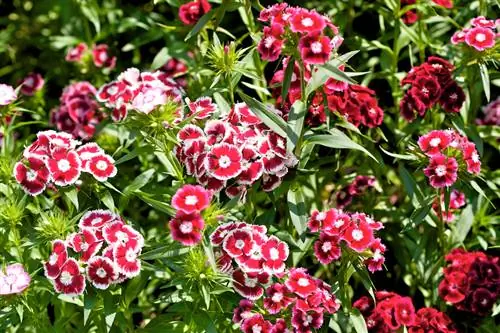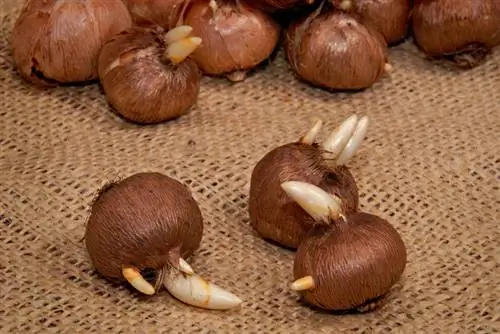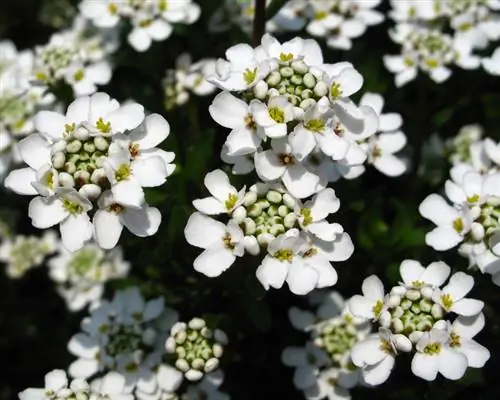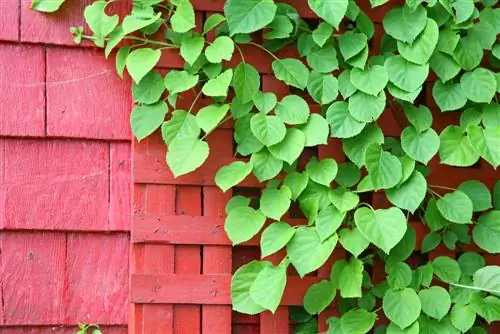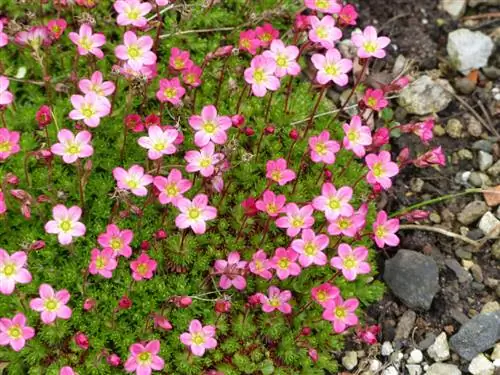- Author admin [email protected].
- Public 2023-12-25 17:45.
- Last modified 2025-01-23 11:20.
The bearded carnation challenges our patience because it only develops its picturesque flowers in its second year. A Dianthus barbatus compensates us for this waiting time with a fireworks display of bright colors and frugal unpretentiousness. The following answers to frequently asked questions show how the nostalgic cottage garden flower transforms your green realm into a sea of flowers.
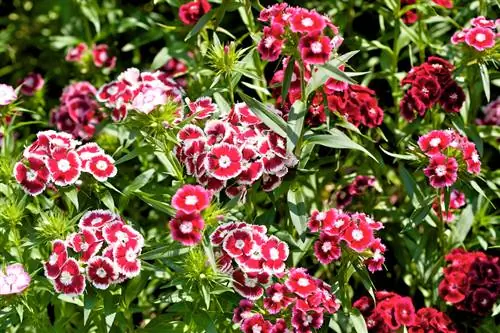
When and under what conditions does the bearded carnation bloom?
The bearded carnation (Dianthus barbatus) is a biennial plant that forms a basal rosette of leaves in the first year and flowers from May to August in the second year. It prefers a sunny location with fresh, moist, humus-rich and slightly alkaline soil.
Planting bearded carnations correctly
You can plant a two-year-old bearded carnation in the garden in two stages. Sow the seeds in the seedbed in May to plant them in their final location in August/September. How to do it right:
- Sow the seeds widely in a fine, crumbly bed in a protected location
- Sift thinly with substrate, press down lightly and water with a fine spray
- Water regularly and weed consistently every few days
- Tip once above the sixth pair of leaves to achieve bushy branching
If the seedbed is crowded, plant the young bearded cloves at a distance of 20-25 cm in the intended location. Enrich the soil there beforehand with compost or bark humus as well as a few handfuls of rock dust or algae lime. Please maintain the existing planting depth and water generously.
Care tips
The be-all and end-all of successful care is regular watering and cleaning out withered flowers. Furthermore, starting fertilization with compost and algae lime gets the bearded carnation going. In the pot, the charming flower enjoys liquid fertilizer every two weeks in June and August. In exposed locations, we recommend winter protection in the form of autumn leaves and pine fronds. Please put planters away in bright winter quarters before the first frost.read more
Which location is suitable?
The bearded carnation thrives vitally and he althily in a sunny location. This applies equally to flowers in beds and pots. Choose a place with loose, humus-rich, nutrient-rich and calcareous soil. Use commercially available potting soil as a substrate (€10.00 on Amazon) and enrich it with a little rock dust or algae lime.
What soil does the plant need?
Characteristic of cottage garden plants is their preference for fresh, moist, humus-rich and nutrient-rich soil. In this regard, the bearded carnation is no exception. In addition, the two-year-old perennial feels particularly well cared for when the soil acidity value of 7.5 to 8.0 shows a slight tendency towards alkaline.
What is the best time to plant?
Two dates are relevant for the proper cultivation of a bearded clove: sowing in the seedbed in May/June and planting in the final location by September at the latest. Anyone who follows this sequence during planting time can look forward to the picturesque flowers in the following early summer.
When is flowering time?
The flowering period of a bearded carnation extends from May/June to August. The two-year-old perennial does not produce its colorful flower dress until the year after sowing and planting. Until then, the Dianthus barbatus develops a basal rosette of leaves that produces the longed-for inflorescence in the following season. To ensure that the charming summer flower retains its radiance over this long period of time, please cut off withered flowers regularly.
Cut the carnation correctly
There are several occasions when you cut the bearded carnation. The following overview gives all the important details:
- During cultivation, trim the seedlings once above the sixth pair of leaves
- For the vase, cut the stems with slightly open buds close to the ground in the early morning
- Clean out wilted flower umbrellas regularly for constant rebloom
In regions with mild winters, there is a prospect of another flower festival next year. In this case, only cut the bearded carnation back to the ground next spring so that the withered leaves protect the root ball from the rigors of winter.
Water the carnation
The bearded carnation reacts to drought stress in an extremely bad-tempered manner by refusing to flower and letting the foliage hang limply. Therefore, water the summer flower regularly if the soil or substrate has dried out. Early in the morning or evening is the best time to pour regular tap water directly onto the root disc.
Fertilize bearded cloves properly
The modest demands of a bearded carnation are expressed not least in the supply of nutrients. An organic starting fertilizer with compost and horn shavings as well as a handful of algae lime cover the needs of the bed. Please fertilize the pot and flower box every 2-3 weeks in June and August with a liquid fertilizer or add fertilizer sticks with a long-term effect to the substrate once.
Wintering
In the year it is planted, the bearded carnation goes into winter with a basal rosette of leaves. To ensure that the cold season does not harm the root ball, we recommend covering rough areas with leaves and brushwood. Since a Dianthus barbatus does not always stick to the two-year life plan, there is a prospect of another flowering period in regions with mild winters. Do not cut back the carnation plant in autumn, but rather spread a protective layer over the planting site again. With a little luck, the flower will sprout again. At least she provided plenty of offspring through self-sowing.
Propagate Bearded Carnation
The meager selection of propagation methods is typical for biennial plants. Only sowing has a chance of success for a bearded carnation. To do this, collect the ripe, approximately 1 cm large capsule fruits at the end of the flowering period. These contain the valuable seeds, which you should keep dark, cool and dry. Sow the seeds directly into the bed in May or June. At temperatures of 15-18 degrees Celsius, germination begins within 7-14 days.
Carnation not blooming
Don't worry about a lack of flowers in the first year. The bearded carnation is designed as a two-year-old perennial. This characteristic implies that a rosette of leaves initially develops in the year of sowing and planting. This overwinters to allow the enchanting inflorescence to rise in the following season.
Beautiful varieties
- Nigrescens: Much-loved carnation that enchants us with velvety, dark red flowers; Growth height 35-40 cm
- Oeschberg: The premium variety exudes a nostalgic flair with bright purple-red flowers; Growth height 40-50 cm
- Scarlet Queen: Royal carnation splendor for the early summer garden and balcony; Growth height 50-60 cm
- Albus: Pure white Dianthus barbatus, which contrasts wonderfully with its colored counterparts; Growth height 50-60 cm
- Homeland: Two-tone classic whose deep red flowers are adorned with a white eye; Growth height 50-60 cm
- Indian carpet: A mix of delicate dwarf varieties, ideal as a bed border and pot flower; Growth height 25 cm

